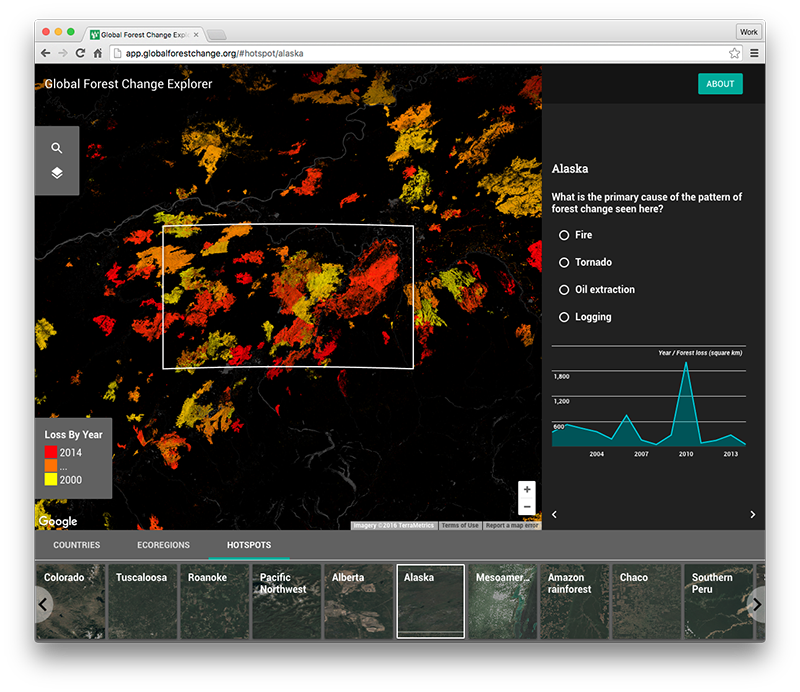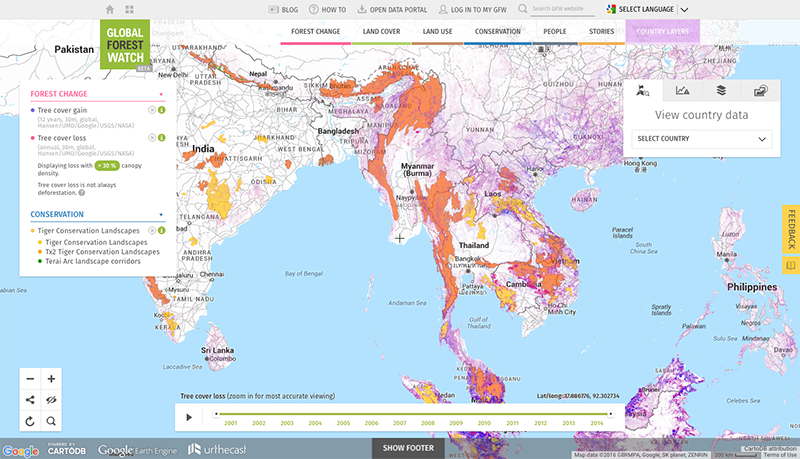Category Archives: Google Green Blog
Bring the world’s changing forests inside the classroom
Source: Energy & Environment
Bring the world’s changing forests inside the classroom
Forests are the mighty lungs of our planet. They absorb carbon dioxide, and emit oxygen on which all people and animals on Earth rely. For the sake of our future, it is critical that all people, including the next generation, understand our global forests in order to manage them sustainably. Today, Science in the Classroom, Dr. Matt Hansen of the University of Maryland, and Google Earth Engine are presenting Global Forest Change Explorer to help engage young people in forest conservation.
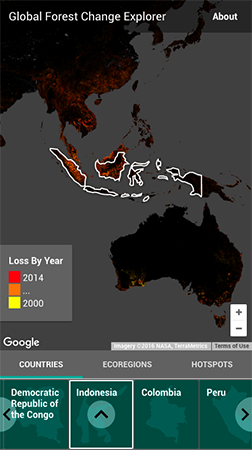
The Global Forest Change Explorer website contains maps that are available for interactive analysis as well as an accompanying activity worksheet. The Explorer Tool allows students to quickly visualize trends in forest loss and gain, compare different countries and ecoregions, and apply the forest data to try to predict underlying causes where there is significant change in forest density. The Explorer Tool relies on open data that is used by remote sensing and GIS professionals in their work.
A number of years ago, Dr. Matt Hansen and a team of researchers at the University of Maryland turned to Google Earth Engine to map high-resolution global forest cover with Earth Engine's cloud-based image processing and computing. The team mapped global forest loss and gain from 2000 to 2012 at 30-meter resolution for the entire globe. In 2013, the methods and results were published in Science Magazine and online for everyone to explore. These findings are now an important part of the website Global Forest Watch, which gives governments and decision makers free access to the data and tools required to monitor and manage their forests.
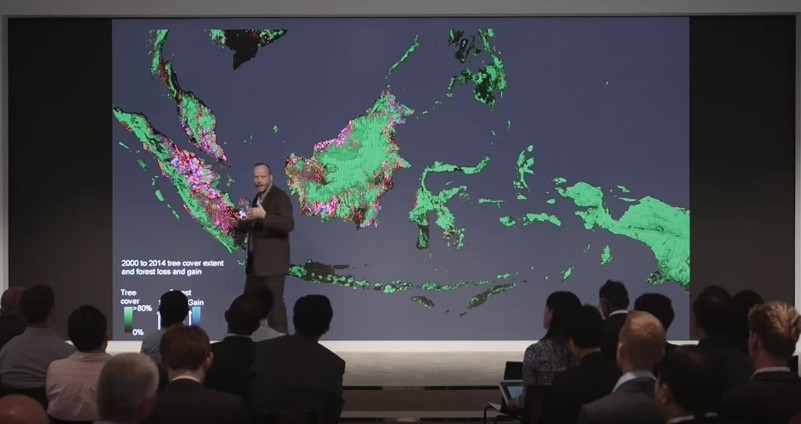
Science in the Classroom (SitC) thought this was great research to bring into the classroom and make available to anyone online. SitC packages annotated research papers with supplemental teaching materials to help pre-college and college students understand the structure and workings of scientific research. SitC and Google Earth Engine built the Global Forest Change Explorer to make Dr. Hansen’s data accessible to a younger audience.
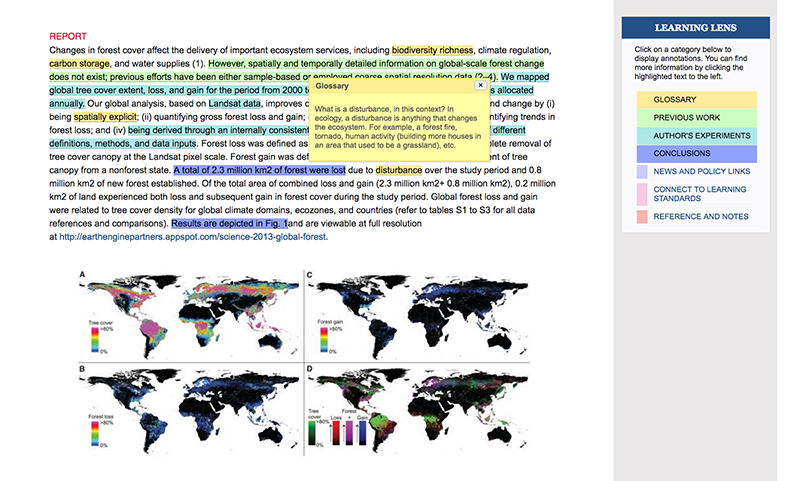
We live in a dynamic world where the pressures of population growth increasingly impact and threaten our forests. However, as technology, open data, and people continue to mobilize, we are given more tools to research the health of our planet. Educators can easily flip their classrooms into science labs by combining SitC materials with Global Forest Change Explorer. With these tools, students will leave sessions with richer understanding of environmental change, more curiosity, and a desire to actively participate in protecting our forests.
Get started with Global Forest Change Explorer today!Source: Energy & Environment
How technology can help us become more sustainable
Source: Energy & Environment
How technology can help us become more sustainable
Monitoring forests and wildlife
Google Earth satellite technology gives scientists and environmentalists a way to measure and visualize changes of the world on both land and water. This technology can have great impact on monitoring endangered animal populations around the world. For example, with the help of Global Forest Watch, powered by Google Earth Engine, scientists at the University of Minnesota are suggesting that wild tiger populations may rebound by 2022, due to the efforts to restore tiger habitats in key regions.Going solar
Looking to generate clean energy savings with solar power on your home? Check out Project Sunroof, a solar calculator that estimates the impact and potential savings of installing solar on the roof of your home. Taking Google Earth imagery and overlaying annual sun exposure and weather patterns, Sunroof is able to assess viable roof space for solar panel installation, estimate the value of solar and savings based on local energy costs, and connect you with providers of solar panels in your area.As of this week, Sunroof expanded to 42 states across the U.S. (from 10 states in December), which makes imagery and data available for a solar analysis to 43 million rooftops. We’re also working with organizations like Sierra Club and their Ready for 100 campaign to help analyze the solar potential of cities across the US.
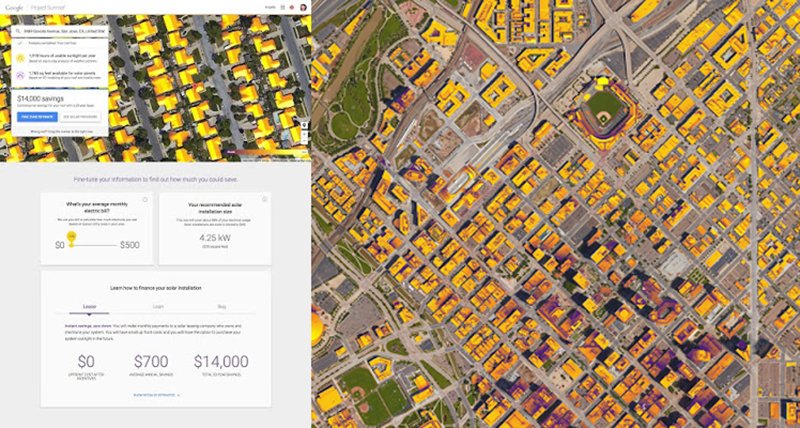
Measuring air pollutants
For the past few years, Google Earth Outreach and the Environmental Defense Fund (EDF) have been working together to map methane leaks from natural gas pipelines under our streets. Since methane is a very potent greenhouse gas (GHG), even small leaks can add up to big emissions that can hurt our climate. By attaching methane analyzers to select Street View cars, we’ve driven more than 7,500 miles and have mapped 4,200+ leaks in 10 cities. What we found ranges from an average of one leak per mile (in Boston) to one leak every 200 miles (in Indianapolis), demonstrating the effectiveness of techniques like using plastic piping instead of steel for pipeline construction. We hope utilities can use this data to prioritize the replacement of gas mains and service lines (like New Jersey’s PSE&G announced last fall). We’re also partnering with Aclima to measure many more pollutants with Street View cars in California communities through this year. Anyone can explore the maps at www.edf.org/methanemaps.Technology is crucial to increasing energy efficiency, raising climate change awareness, and sustainability efforts. To learn more about what you can do to help, take a moment to explore our Google Earth Outreach site, where these tools and more are described in depth.
Source: Energy & Environment
Laying the foundation for renewable energy certification programs in Asia
Source: Energy & Environment
Laying the foundation for renewable energy certification programs in Asia
At Google, we’ve made a long term commitment to power 100% of our operations with renewable energy. To that end, we’ve purchased more than 2 gigawatts of renewable energy to date, making us the world’s largest non-utility purchaser of renewables.
Our data centers – including our facilities in Taiwan and Singapore that help us provide people in Asia with faster, more reliable access to our tools and services – make up the majority of our electricity consumption. We are working to power all of our data centers around the world with renewable energy, but one of the challenges we face in Asia is that effective renewable energy certification programs simply aren’t available.
To help address this, we’re announcing today that we’re providing seed funding to theCenter for Resource Solutions (CRS) to begin laying the groundwork to establish such programs across Asia, starting in Taiwan. They have over 20 years of experience developing and operating renewable energy certification programs.
These kinds of programs are key in helping companies like Google actually know that the power we are buying comes from a renewable source. They work by “tagging” each MWh of energy generated from a source like wind or solar as renewable, which creates a renewable energy certificate (“REC”). This is especially important to us in Taiwan, where we are actively looking to purchase renewable energy for our data center.
The video below from CRS explains how this works for some customers. In Google’s case, we buy both the physical power and the RECs associated with that power, providing us with both the financial benefits of renewable energy and the assurance that the electricity we are buying is in fact renewable.
It may not sound like much, but these programs are critical to creating well-functioning voluntary renewable energy markets. For the dozens of Fortune 100 and Global 100 companies that have renewable energy commitments, RECs are a critical instrument to ensuring that renewable energy purchasing claims are accurate and verifiable. They have played a key role in enabling companies in the United States to grow their renewable energy purchasing from about 100 MW in 2012 to over 3,000 MW last year.
With this support from Google, CRS will begin examining how best to structure these programs across Asia to create robust voluntary renewable energy markets. They will also begin building a coalition of international stakeholders from the public, private, and NGO sectors to drive these efforts forward.
Organizations interested in supporting these efforts may get more information here.
Source: Energy & Environment
Laying the Foundation for Renewable Energy Certification Programs in Asia
Our data centers – including our facilities in Taiwan and Singapore that help us provide people in Asia with faster, more reliable access to our tools and services – make up the majority of our electricity consumption. We are working to power all of our data centers around the world with renewable energy, but one of the challenges we face in Asia is that effective renewable energy certification programs simply aren’t available.
To help address this, we’re announcing today that we’re providing seed funding to the Center for Resource Solutions (CRS) to begin laying the groundwork to establish such programs across Asia, starting in Taiwan. They have over 20 years of experience developing and operating renewable energy certification programs.
These kinds of programs are key in helping companies like Google actually know that the power we are buying comes from a renewable source. They work by “tagging” each MWh of energy generated from a source like wind or solar as renewable, which creates a renewable energy certificate (“REC”). This is especially important to us in Taiwan, where we are actively looking to purchase renewable energy for our data center.
The video below from CRS explains how this works for some customers. In Google’s case, we buy both the physical power and the RECs associated with that power, providing us with both the financial benefits of renewable energy and the assurance that the electricity we are buying is in fact renewable.
It may not sound like much, but these programs are critical to creating well-functioning voluntary renewable energy markets. For the dozens of Fortune 100 and Global 100 companies that have renewable energy commitments, RECs are a critical instrument to ensuring that renewable energy purchasing claims are accurate and verifiable. They have played a key role in enabling companies in the United States to grow their renewable energy purchasing from about 100 MW in 2012 to over 3,000 MW last year.
With this support from Google, CRS will begin examining how best to structure these programs across Asia to create robust voluntary renewable energy markets. They will also begin building a coalition of international stakeholders from the public, private, and NGO sectors to drive these efforts forward.
Organizations interested in supporting these efforts may get more information here.
Source: Google Green Blog
Google unites with other tech companies to support US Clean Power Plan
Source: Energy & Environment
Google unites with other tech companies to support US Clean Power Plan
Today Google, along with Amazon, Apple and Microsoft, filed a legal brief with the DC Circuit Court supporting the Environmental Protection Agency’s Clean Power Plan. The CPP aims to accelerate the transition to cleaner sources of electricity and puts an emphasis on renewable energy development and energy efficiency. The plan has been put on hold pending the outcome of a legal challenge.
Google, Amazon, Apple and Microsoft have come together in this brief to offer our unique view as large consumers of energy. Collectively we used 10 million MWh of electricity last year, including at 50 data centers in 12 states. That means reliable and affordable electricity is integral to the continued growth and operation of all of our businesses and the services we offer to our users everywhere. We are all committed to sourcing our power in a sustainable way, and renewable energy makes good business sense for us all.
At Google, we have been carbon neutral since 2007. We have signed contracts to purchase over 2GW of renewable energy — equivalent to taking nearly one million cars off the road — making us the largest non-utility renewable energy purchaser in the world. Just last year we signed the largest and most diverse purchase of renewable energy made by a non-utility company to power our data centers. The deal covers a series of new wind and solar projects around the world and takes us one step closer to our goal of powering 100% of our operations with clean energy. Above and beyond our own power purchases, we have also invested more than $2.5 billion in 22 other renewable projects around the world.
These efforts underline the seriousness of our commitment to renewables and we believe the CPP is an important step in the transition to a cleaner energy future. The message from our companies today is clear — we can meet the world’s future energy challenges in a way that drives innovation and growth while tackling climate change.
